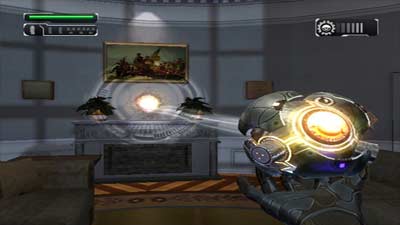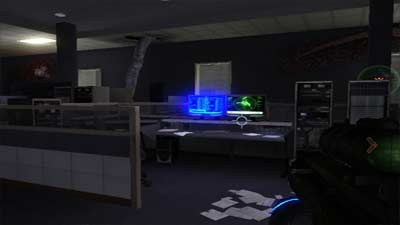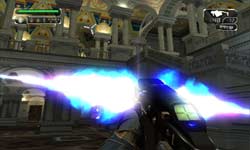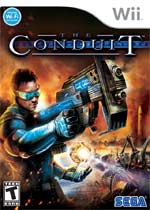If you’re a Wii owner like myself, you likely have a fair amount of dust amassing on top of your little white wonder. When the console was first launched, the idea of motion controls seemed so promising, especially for genres such as first-person shooters (FPS) that could take full advantage of the pinpoint accuracy provided by the sensor bar. Unfortunately, in reality the potential for the Wii’s motion controls to revolutionize how we play games has still gone largely untapped in most of the console’s third-party FPSs. Anybody remember Far Cry Vengeance or Red Steel fondly? Nope, didn’t think so.

Now there are likely some exceptions to this reality, but for the most part, if you’ve wanted a quality FPS title that made respectable use of Wii’s motion controls, you’ve had to exclusively rely on the Metroid Prime series. This is partially what has spawned the massive hype tornado that has been following The Conduit, sucking up every Wii owner looking for a decent FPS on the system that isn’t Metroid-based or on rails since it was shown at E3 2008. It is a game that has been built from scratch with the Wii in mind by High Voltage Software that looks to take advantage of the console’s strengths and prove that third-parties really can make a good FPS on the Wii. Did they succeed in the way that most Wii owners were hoping for? Not entirely, but in many ways, yes they did.
With controls being so crucial to the overall enjoyment of most Wii games, I’m pretty happy with how The Conduit handles itself. While the default controls frustrated me quite a bit for reasons I’ll get to in a second, nothing is set in stone. Instead, High Voltage took the “if you don’t like it this way, then figure it out for yourself” approach and it works for the most part. The biggest problem is that the Wii-mote and Nunchuk don’t have enough easily reachable buttons between them to ensure you won’t need to waggle one or the other for something important. The default controls place grenade tosses as a Nunchuk waggle and melee attacks as a Wii-mote one. Tell me, how are you supposed to perform a melee attack when you need to be able to see and precisely shoot enemies? The answer is poorly, as you’ll wind up disoriented and pointed every which way by the time it actually registers, resulting in many needless deaths.

However, like I said, everything can be tweaked to varying degrees, so you can try to account for some of these issues. Players can move heavily used abilities such as melee attacks and grenades to buttons and replace them with less critical things such as pausing the game or switching between different grenade types, although you’ll still probably have to make some long reaches to the one and two buttons and D-pad directions for some stuff. Getting more intricate, players can also adjust their bounding box, walking speed, control sensitivity, waggle sensitivity, and just about anything else you can think of. Perhaps the best part of this is how some of these are presented. When making adjustments to how quickly your character will turn during the game, you do so with your character still moving around, allowing you to tweak it until it feels just right without having to go in and out of menus.
Graphics that verged on Xbox 360 and PS3 levels were also supposed to be a major selling point of The Conduit, but the visuals are somewhat of a mixed bag. There are definitely certain things in the game that will leave you questioning which console you’re playing, but far too many that will instantly remind you. Things like the All Seeing Eye, your weapons, your hands, cinematics, lighting effects, and water all look phenomenal. However, the environments you make your way through are mostly generic-looking and are comprised of blurry and bland textures, you’ll see the same few enemies and death animations the whole way through, and sometimes the blur effect utilized when reloading or zoomed in with a weapon is overly drastic. Still, the bright spots are definitely well done, though, and really leave me wanting to see more upcoming Wii titles making use of the impressive Quantum3 engine used in the game.

Sadly, the story in The Conduit is pretty cliché, although I do give it credit for trying to keep players interested. It revolves around the game’s main character Michael Ford, who is recruited by a secretive organization known as the Trust. Very early in the game you’re following orders from the Trust and trying to hunt down Prometheus, a character you know little about other than it’s your job to take him down and retrieve a prototype called the All Seeing Eye in order to help the Trust to combat an impending alien attack. From there, the story makes some pretty obvious twists and turns, but I’ll remain spoiler free and leave those for you to discover on your own. Just know that there is clearly an intention here to make a sequel.

Beside using the All Seeing Eye frequently to solve minor puzzles, find hidden weapon caches, hack computers and doors, uncover data disks and invisible messages, and to deactivate invisible mines, the gameplay in The Conduit is very straightforward. You are able to carry two weapons at a time, which you can switch out when you find better options, be them human or alien-based, in order to make quicker work of the opposition. You’ll need to make quick and effective use of your available weaponry in order to survive, as you are constantly led through the game’s incredibly linear levels, basically just moving down corridors from one enemy kill room to the next. The twist here, though, is that you don’t always know whether they’ll eventually stop coming if you simply just kill enough of them or if you actually have to find where they’re spawning and destroy whatever is causing it. It may initially seem like standing your ground is the best course of action, but you might just have to somehow wade through the horde of never-ending aliens in order to find the pod or conduit which is continually sending even more your way. This can get pretty frustrating, especially with some being difficult to find, such as being tucked away in a dark corner on the ceiling.
However, if playing against human opponents online is more your style and you only own a Wii, then you simply need to pick up The Conduit. With perhaps the best online component of any FPS on the Wii, The Conduit provides a wide assortment of modes and options to enjoy with up to twelve players, even with voice chat between friends thanks to Wii Speak support. Before every match of free for all, team reaper, and team objective play, players are given the ability to vote on what rules are used, the weapon set, and which map is played, with the most popular in each category being used. Some highlights of the rule sets include ASE Football (basically like Oddball from Halo 3), Last Man Standing (whoever is left alive wins), and Bounty Hunter. Bounty Hunter is by far the most interesting, as it tasks each player with killing a specific enemy and penalizes them for killing anyone else. For the most part, the online play works without a hitch but if you’re up against some players with slower connections, you will have to deal with some lag jumping that can get very irritating.
There are definitely some good things happening in The Conduit that many third-party developers could learn from, but there is certainly still room for improvement here. With its inconsistent visuals, reliance on disorienting waggles for some abilities, cliché storyline, and the linear and often frustrating design of the single-player experience in this game likely won’t pull many multiple console owners away from their plethora of readily available FPSs. However, if you only own a Wii, this game does provide sporadically impressive visuals, one of the best online experiences on the console, perhaps the best/most customizable controls of any Wii FPS, and a reason to blow the dust off of your system for awhile. So, while The Conduit doesn’t end up being the Wii’s Halo 3 or Killzone 2, it is a pretty good game that will likely be very appreciated by anyone who only owns a Wii and has been anxiously awaiting another FPS that’s worthy of investing some time into.
RATING OUT OF 5 RATING DESCRIPTION 3.9 Graphics
While there are some pretty impressive visuals for certain things, there are also a ton of blurry and bland textures making up the game’s environments. 3.9 Control
Although the controls still aren’t completely perfect, at least you are given the ability to tweak and customize just about every aspect of them. 3.9 Music / Sound FX / Voice Acting
The enemies sound like they came directly out of Halo, but the music is good and there is also some competent voice acting from the likes of Kevin Sorbo (Hercules: The Legendary Journeys). 4.0
Play Value
The single-player experience, while being far from terrible, is incredibly linear, repetitive, and can get rather frustrating due to endlessly respawning enemies. The multiplayer on the other hand is some of the best on the console, with enough variety to keep you coming back for more.
3.9 Overall Rating – Good
Not an average. See Rating legend above for a final score breakdown.
Game Features:
